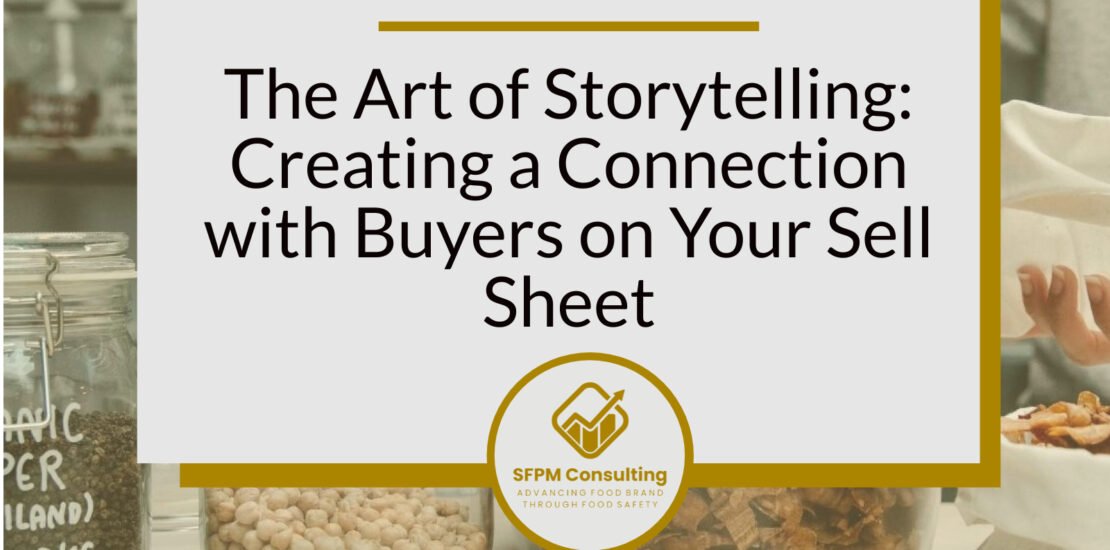The Art of Storytelling: Creating a Connection with Buyers on Your Sell Sheet
- May 2, 2023
- Posted by: Felicia
- Categories: Advices, Blog, Business, English, Start-Up

As a food manufacturer or brand, you know how important it is to stand out in a crowded market. One way to do this is by telling your food brand story on your sell sheet. By sharing your history, values, and personal anecdotes, you can build a connection with buyers and make your product more memorable. In this article, we’ll explore the art of storytelling on a sell sheet and provide tips for effectively incorporating your company’s story.
Your sell sheet is a powerful tool for showcasing your product and convincing store buyers to carry it. However, it’s not enough to list the features and benefits of your product. To truly stand out, you need to tell your company’s story. Sharing your journey and values can help build a connection with buyers and differentiate your product from competitors. This article will provide tips for effectively incorporating your company’s story into your sell sheet.
Identify Your Company’s Story
Understanding what that story is one of the most important steps in effectively telling your company’s story on your sell sheet. Your company’s story is the unique combination of your history, values, and mission that sets your brand apart from the competition. This information can help you identify the key elements that make your product special and compelling to buyers.
Start by identifying your company’s history, including its founding and any significant milestones or achievements. Look for stories and events demonstrating the passion and drive behind your brand and any challenges you have overcome. These elements can be woven into your sell sheet to help create a more personal and relatable connection with buyers.
In addition to your company’s history, it’s important to consider your values and mission.
- What inspired you to start this business? OR What are the driving forces behind your brand?
- What values drive your decisions?
- What sets your product apart from competitors?
- What do you believe in and stand for?
Identifying these core values can help create a more authentic and impactful story on your sell sheet.
Incorporating Your Story into Your Sell Sheet
Once you’ve identified your food brand story, it’s time to incorporate it into your sell sheet. One way to do this is by choosing the right language and tone. Use language that reflects your company’s values and mission.
For example, if sustainability is important to your company, use phrases like “earth-friendly” or “sustainably sourced.”
Consider starting with a headline that captures the essence of your story and draws the reader in. Use simple, clear, and relatable language, and avoid technical jargon or complex language that may be difficult for buyers to understand.
Additionally, consider the tone you want to convey. Do you want to come across as serious and professional or playful and fun? Make sure your language and tone are consistent with your branding and values.
Regarding design elements, consider incorporating images and graphics that support your story and reinforce the key messages you want to communicate.
- For example, if your food company is strongly committed to sustainability, you might include images of your eco-friendly packaging or graphics highlighting your carbon footprint.
- For example, if a family recipe inspired your food company, consider including a photo or a graphic highlighting its unique flavours.
Showcasing Your Differentiation
In addition to telling your company’s story, it’s important to communicate what sets your product apart from the competition effectively. This could be a unique ingredient, a special recipe, or a proprietary production process.
This can also include your unique selling points, such as high-quality ingredients, innovative packaging, or certifications like organic or gluten-free. Use language and graphics that highlight these features and emphasize why they matter. For example, if your product is organic, explain the benefits of organic ingredients, such as being free from pesticides and harmful chemicals.
When showcasing your differentiation, focus on your product’s benefits to the buyer.
- Why should they choose your product over others on the market?
- What makes your product stand out in terms of taste, quality, or convenience?
It’s also important to be truthful and transparent in your messaging. Buyers are savvy and can easily spot exaggerations or misleading claims. Instead, focus on what truly sets your product apart and be confident in the value it provides.
By effectively incorporating your company’s story and differentiation into your sell sheet, you can create a more engaging and memorable document that helps build a connection with buyers and ultimately drives sales.
Adding a Personal Touch
One way to build a connection with buyers is by incorporating personal anecdotes or experiences into your sell sheet. This can include sharing how you developed your product or the challenges you faced. Sharing your journey can make your product more relatable and memorable. Additionally, consider incorporating customer testimonials or quotes from industry experts. This can help build credibility and persuade buyers to carry your product.
In conclusion, storytelling is a powerful tool for connecting with buyers and differentiating your product. By identifying your company’s story, incorporating it into your sell sheet, showcasing your differentiation, and adding a personal touch, you can create a sell sheet that truly stands out. Remember to use truthful language and design elements that reflect your branding and values, and don’t be afraid to get creative.
